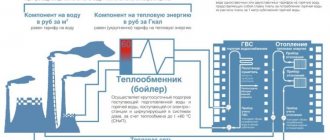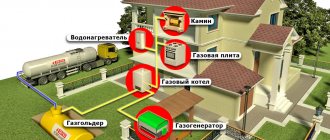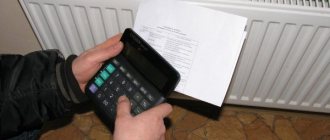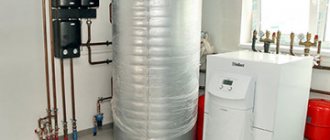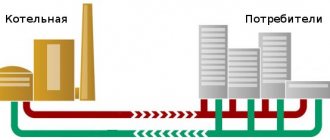Everyone, at least indirectly, is familiar with the concept of “calorie”. What is it and what is it for? What exactly does it mean? Such questions arise, especially if you need to increase it to kilocalories, megacalories or gigacalories, or convert it to other quantities, for example Gcal to kW.
- 2 What is a Gigacalorie, and how many calories are in it?
- 3 Gcal and Gcal/h: what is the difference
- 4 How are Gcal calculated for hot water and heating
4.1 Video: example of calculating heating fees
What is a calorie?
The calorie is not part of the international metric measurement system, but the concept is widely used to denote the amount of energy released. It indicates how much energy must be expended to heat 1 g of water so that this volume increases the temperature by 1 °C under standard conditions.
There are 3 generally accepted designations, each of which is used depending on the area:
- The international value of a calorie, which is equal to 4.1868 J (Joule), and is designated as “cal” in the Russian Federation and cal in the world;
- In thermochemistry - a relative value approximately equal to 4.1840 J with the Russian designation calth and the worldwide designation calth;
- A 15-degree calorie value equal to approximately 4.1855 J, which is known in Russia as “cal15”, and in the world as cal15.
Initially, the calorie was used to find the amount of heat released during the generation of fuel energy. Subsequently, this value began to be used to calculate the amount of energy expended by an athlete when performing any physical activity, since the same physical laws apply to these actions.
Since fuel is needed to generate heat, then, by analogy with heat energy in simple life, to produce energy the body also needs “refueling” - food that people take regularly.
A person receives a certain amount of calories, depending on what product he consumes.
The more calories a person receives from food, the more energy he receives for exercise. However, people do not always consume the amount of calories that is necessary to maintain normal vital processes of the body and perform physical activity. As a result, some people lose weight (with a calorie deficit), while others gain weight.
Calorie content is the amount of energy received by a person as a result of the absorption of a particular product.
Based on this theory, many principles of diets and rules of healthy eating are built. The optimal amount of energy and macronutrients that a person needs per day can be calculated in accordance with the formulas of famous nutritionists (Harris-Benedict, Mifflin-St. Geor), using standard parameters:
- Age;
- Height;
- Weight;
- Example of daily activity;
- Lifestyle.
These data can be used by changing them to suit you - for painless weight loss it is enough to create a deficit of 15-20% of daily calories, and for healthy weight gain - a similar surplus.
About units of measurement
The basic unit of heat measurement is the calorie; it is currently considered a non-system unit. This is how it happened historically: several types of calories are used, which introduces some confusion (just think about the calorie content of food).
Since water is usually the coolant in heating systems, one calorie refers to the amount of heat that can heat 1 gram of water by 1°C (the ratio is valid for normal atmospheric pressure).
For use in calculating heat costs for heating, this value is too small and inconvenient. In practice, they use gigacalorie (Gcal), or billion calories, a number with nine zeros. To understand the order of Gcal in heating calculations, it is better to translate it into a visual form: a resource of 1 Gcal is enough to heat a thousand tons of water (the same 9 zeros) by one degree.
To paraphrase, 1 gigacalorie can heat 1000 cubic meters of water by 1°C or, if you make a simple calculation, approximately 16.7 cubic meters by 60°C. This order of numbers can be used in practice, for example, to evaluate the performance of a DHW meter.
Heat energy metering unit Source sovintervod-vnt.ru
In the international SI system, energy (including heat) is measured in Joules (J), and Gcal is considered an outdated method of calculation. However, it is officially used in the Russian Federation for settlements in municipal and private households. In addition to Gcal, the following derived units are used:
- Gcal/hour (gigacalorie per hour). As a quantity, it is equivalent to thermal power. It is used to determine how much thermal energy is produced (or used) per unit of time.
- Gigacalorie per square meter. Shows the consumption of thermal energy for heating any area. On the territory of the Russian Federation, the value is introduced by the “Rules for Accounting for Thermal Energy and Coolant”. It is also used for calculations by the “Rules for the Provision of Public Utilities”.
There is a concept of standard heat consumption per month. The indicator has different meanings in different climatic zones; The average regional standard is 0.0342 Gcal/m² (per month).
Heating and water supply diagram for a residential building Source moydom.ru
What is a Gigacalorie and how many calories are in it?
The concept of Gigacalories is most often found in documents in the field of thermal power engineering. This value can be found in receipts, notices, payments for heating and hot water.
It means the same thing as a calorie, but in a larger volume, as evidenced by the prefix “Giga”. Gcal determines that the original value has been multiplied by 109. In simple terms: 1 Gigacalorie contains 1 billion calories.
Like the calorie, the Gigacalorie does not belong to the metric system of physical quantities.
The table below shows an example comparison of values:
| Console | Number of calories |
| kcal (kilocalorie) | 1 000 |
| Mcal (megacalorie) | 1 000 000 |
| Gcal (gigacalorie) | 1 000 000 000 |
The need to use Gcal is due to the fact that when heating the volume of water needed for heating and household needs of the population, even 1 residential building releases a colossal amount of energy. Writing numbers denoting it in documents in calorie format is too long and inconvenient.
A value such as a gigacalorie can be found in payment documents for heating
You can imagine how much energy is spent during the heating season on an industrial scale: when heating 1 block, district, city, country.
Briefly about the main thing
The question of how thermal energy is measured arises when it is necessary to calculate a heating system. It is important to perform the calculation correctly, especially for owners of their own home. If, as a result of an error, you purchase a low-power boiler, you will waste electricity for secondary heating of your home. A boiler with an excessive power reserve will also be a mistake: operating at half the power, it will consume almost the same amount of energy resources.
A visual unit for calculating heat consumption is the gigacalorie. Consumption is calculated using different methods, which depends on the type of housing, whether it is an apartment building or a private one. Counting techniques also vary; they depend on the characteristics of the system, the availability and type of measuring devices.
Gcal and Gcal/h: what is the difference
If it is necessary to calculate the consumer's payment for state heat and power services (house heating, hot water), the value Gcal/h is used. It denotes a reference to time - how many Gigacalories are consumed during heating for a given period of time. Sometimes it is also replaced by Gcal/m3 (how much energy is needed to transfer heat to a cubic meter of water).
The value of Gcal/h can be calculated independently using this formula:
Q=V*(T1 – T2)/1000, where
- Q – amount of thermal energy;
- V – volume of liquid consumption in cubic meters/tons;
- T1 is the temperature of the incoming hot liquid, which is measured in degrees Celsius;
- T2 – temperature of the incoming cold liquid, similar to the previous indicator;
- 1000 is an auxiliary coefficient that simplifies calculations by eliminating numbers in the tenth digit (automatically converts kcal to Gcal).
This formula is often used to construct the operating principle of heat meters in private apartments, houses or enterprises. https://profikarkas.com.ua/ - frame houses in Kyiv. This measure is necessary when the cost of this utility service sharply increases, especially when calculations are generalized based on the area/volume of the room that is heated.
If a closed type system is installed in the room (hot liquid is poured into it once without additional water), the formula is modified:
Q= (( V1* (T1 – T2)) – (V2* (T2 – T)))/ 1000, where
- Q – amount of thermal energy;
- V1 – volume of consumed thermal substance (water/gas) in the pipeline through which it enters the system;
- V2 is the volume of thermal substance in the pipeline through which it returns;
- T1 – temperature in degrees Celsius in the inlet pipeline;
- T2 – temperature in degrees Aim in the outlet pipeline;
- T – cold water temperature;
- 1000 – auxiliary coefficient.
This formula is based on the difference between the inlet and outlet values of the coolant in the room.
Depending on the use of a particular energy source, as well as the type of thermal substance (water, gas), alternative calculation formulas are also used:
- Q= (( V1* (T1 – T2)) + (V1 – V2)*( T2 – T))/1000
- Q= (( V2* (T1 – T2)) + (V1 – V2)*(T1 – T))/1000
In addition, the formula changes if electrical devices are included in the system (for example, heated floors).
Features of thermal power metering
As a rule, during the construction of buildings for various purposes, all thermal calculations are made in Gcal and the main reason for this is the proximity of the data obtained to the real situation and the possibility of obtaining reliable data that will be as reliable as possible for both a large industrial facility and a small building. That is, using this unit of measurement, you can correctly and accurately calculate the amount of thermal energy required, sufficient to create the optimal temperature regime in the room.
But at the same time, when calculating the required amount of thermal energy, it is important to understand that its production will be ensured through the operation of heating equipment. And the technical capabilities of equipment are defined as power and measured in kW. Thus, there is a need to convert one value to another, that is, it is necessary to select a boiler or other heat-generating equipment whose power is sufficient to produce the required amount of thermal energy, measured in Gcal.
You should also pay attention to the fact that the need to convert kW to Gcal also appears if heat meters are used, the consumption of which is recorded in kW, that is, in essence, the power characteristics of the coolant pumped through the heating system are determined . Although you need to pay attention to the fact that many heat meters, especially domestic ones, are adapted to the Russian accounting system and show exactly the consumption of thermal energy, that is, they keep records in Gcal. In this case, the consumer does not need to engage in additional calculations, but in other cases, he needs to know how to convert the values obtained in kW to Gcal.
How are Gcal calculated for hot water and heating?
Heating is calculated using formulas similar to the formulas for finding the value of Gcal/h.
An approximate formula for calculating payment for warm water in residential premises:
P i gv = Vi gv * T x gv + (V v cr * Vi gv / ∑ Vi gv * T v cr)
Values used:
- P i gv – the required value;
- V i gv – volume of hot water consumption for a certain time period;
- T x gw – established tariff fee for hot water supply;
- V v gv – the volume of energy expended by the company that heats it and supplies it to residential/non-residential premises;
- ∑ V i gw – the sum of warm water consumption in all rooms of the house in which the calculation is made;
- T v gv – tariff payment for thermal energy.
This formula does not take into account the atmospheric pressure indicator, since it does not significantly affect the final desired value.
The formula is approximate and is not suitable for independent calculation without prior consultation. Before using it, you need to contact local utility services for clarification and adjustment - perhaps they use other parameters and formulas for calculation.
Calculating the size of the heating fee is very important, since often impressive amounts are not justified
The result of the calculations depends not only on the relative temperature values - it is directly influenced by the tariffs established by the government for the consumption of hot water supply and space heating.
The computational process is greatly simplified if you install a heating meter in an apartment, entrance or residential building.
It is worth considering that even the most accurate meters can allow errors in calculations. It can also be determined by the formula:
E = 100 *((V1 – V2)/(V1 + V2))
The presented formula uses the following indicators:
- E – error;
- V1 – volume of hot water supply consumed upon receipt;
- V2 – consumed hot water at the outlet;
- 100 is an auxiliary coefficient that converts the result into percentages.
In accordance with the requirements, the average error of the calculation device is about 1%, and the maximum permissible is 2%.
Video: example of calculating heating fees
Heat meters
Before calculating thermal energy in Gcal, you need to have practical information on hand. To calculate heating for a specific section of the system, the following data will be required:
- Temperature of the working medium (usually water) at the inlet and outlet.
Wiring a heat meter in an apartment Source wikimedia.org
- Water consumption (when passing through heating devices).
To measure temperature, various thermometers are used: from household and alcohol thermometers, to electric and infrared. It is convenient to determine the flow rate of the working medium using a meter; There are two types of heat metering devices.
Impeller counter
A mechanical meter (another name is tachometer) operates at temperatures from +5 to +150°C, and is also used for heating systems, for hot and cold water supply. The devices are divided into turbine and screw (according to the installation method). They react poorly to mechanical impurities, so the system must have a coarse filter. The impeller counter works according to the following principle:
- Water enters the meter, where there is an impeller with magnets installed on it.
- The impeller begins to rotate, and the number of revolutions is directly proportional to the amount of water flowing.
- The rotation is recorded by an accounting mechanism that is capable of processing incoming information and converting the number of revolutions into the volume of flowing water.
Mechanical heat meter Source pechiexpert.ru
Despite the simple design, meters with an impeller have proven themselves to be reliable devices with a fairly low response threshold. In addition, the units are equipped with an anti-magnetic screen, which prevents attempts by external influence on their operation
Gcal in private homes
If we talk about Gcal in a private house, then residents are primarily interested in the cost of heat energy for each type of fuel. Therefore, let’s look at some prices per 1 Gcal for various types of fuel:
- Natural gas – 3300 rubles;
- Liquefied gas – 520 rubles;
- Coal – 550 rubles;
- Pellets – 1800 rubles;
- Diesel fuel – 3270 rubles;
- Electricity – 4300 rubles.
The price may vary depending on the region, and it is also worth considering that the cost of fuel increases periodically.
Gcal in apartment buildings
In apartment buildings, gigacalories are used in thermal calculations. If you know the exact amount of heat energy that remains in the house, you can calculate the bill for heating. For example, if a house does not have a communal or individual heating device installed, then you will have to pay for centralized heating based on the area of the heated room. If a heat meter is installed, then the wiring is horizontal, or serial, or collector. In this option, two risers are made in the apartment for the supply and return pipes, and the system inside the apartment is determined by the residents. Such schemes are used in new houses. That is why residents can independently regulate the consumption of thermal energy, making a choice between comfort and savings.
The adjustment is made as follows:
- Due to the throttling of heating batteries, the passage of the heating device is limited, therefore, the temperature in it decreases and the consumption of thermal energy decreases.
- Installation of a general thermostat on the return pipe. In this option, the flow rate of the working fluid is determined by the temperature in the apartment, and if it increases, then the flow rate decreases, and if it decreases, then the flow rate increases.
What is Gcal?
A calorie is a certain amount of energy that is required to heat 1 gram of water to 1 degree. This condition is met under atmospheric pressure conditions. For thermal energy calculations, a larger value is used - Gcal. A gigacalorie corresponds to 1 billion calories. This value began to be used in 1995 in accordance with the document of the Ministry of Fuel and Energy.
In Russia, the average consumption per 1 sq.m. is 0.9342 Gcal per month. In each region, this value may change up or down depending on weather conditions.
What is a gigacalorie if it is converted into ordinary values?
- 1 Gigacalorie equals 1162.2 kilowatt-hours.
- In order to heat 1 thousand tons of water to a temperature of +1 degree, 1 gigacalorie will be required.
